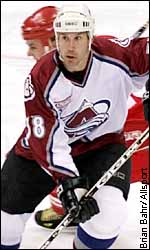| | By Brian A. Shactman
ESPN.com
With 319 members, 218 of whom were players, the Hockey Hall of Fame is considered one of the easier hallowed halls to enter relative to the other three major North American professional sports. The truth of that statement can be debated, but the more interesting discussion is this: How easy it will be to enter in the next decade or so.
|
50-GOAL SCORERS
|
|
Year
|
No.
|
Most goals
|
|
1990
|
8
|
72 (Brett Hull)
|
|
1991
|
4
|
86 (Hull)
|
|
1992
|
4
|
70 (Hull)
|
|
1993
|
14
|
76 (A. Mogilny, T. Selanne)
|
|
1994
|
9
|
60 (Pavel Bure)
|
|
1996
|
8
|
69 (Mario Lemieux)
|
|
1997
|
4
|
52 (Keith Tkachuk)
|
|
1998
|
4
|
52 (Selanne)
|
|
1999
|
0
|
|
Disparities between eras and achievement benchmarks exist within particular sports, but the extreme swings in offensive production in the NHL raises major questions regarding the worthiness of future inductees. It's an issue not remarkably unlike the proliferation of home runs in Major League Baseball, although in the NHL, the pendulum of production swings both ways.
The easiest statistic to display the offensive shifts is the number of 50-goal scorers in a season. In the '80s, the lowest number of players to hit the plateau was five ('86-87), with the highest being 10 ('80-81). In the '90s, the peak was 14 in the '92-93 season, which was the high point of a three-year period that saw the 50-goal barrier broken 31 times -- the most in any three-year period in league history.
That brings us to the low point in the past decade: 1998-'99. That stellar season did not produce one 50-goal scorer. In six seasons, the NHL went from 14 to zero. Put that on a chart and you get a stock market crash-like dip. And the fact that Pavel Bure was the only player to notch more than 50 tallies (58) this season officially makes it a pattern and not an anomaly.
|  | | Dave Andreychuk had five huge seasons to put his numbers in Hall of Fame territory. |
So, in terms of the Hockey Hall of Fame, what happens with players who end their careers reaching the 500-goal-and-up benchmarks yet played their primes in the roaring '90s? Or what about the great offensive talents playing today who may struggle to reach those milestones because of the asphyxiating neutral-zone trap?
Dave Andreychuk and Paul Kariya serve as good examples. Before the 1990 season, Andreychuk's season high was 36 goals. But from 1990-94, he scored 224 goals. That's more than 40 percent of his career production -- spanning 18 seasons -- in just five seasons. Luc Robitaille -- 248 in that span, compared to 553 career goals -- is another one.
Then there's Kariya, who entered the league in the 1994-95 season, just as the scoring spree was coming to an end. Yet, he has 210 goals in 376 games, including 81 the last two seasons. Imagine how many he would have had in the early '90s?
Of course, it's a little silly because a player enters the league when he enters, and there's nothing to be done about it. But there are players like Andreychuk -- seemingly borderline until looking at the numbers -- who likely will get in because of their career totals. And with 218 player inductees in 55 years, that's consistent with what's been the case so far in the Hockey Hall of Fame.
Brian A. Shactman is the hockey editor at ESPN.com | |
ALSO SEE
Garber: What is a Hall of Famer?
Baseball: A battle at the border
Football: Fame is name of game
Basketball: Open to all
|

